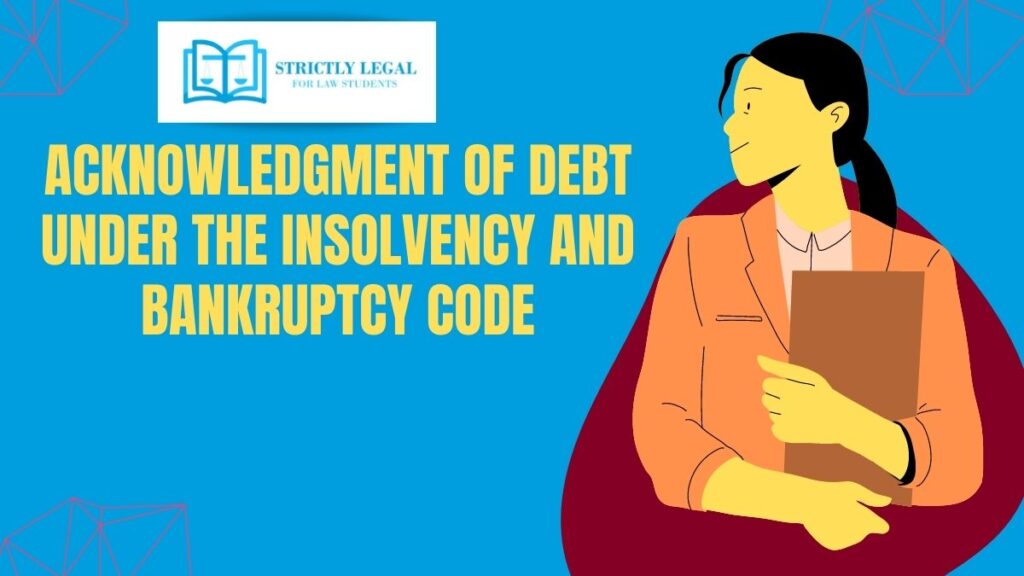It is a well-known fact that the Insolvency and Bankruptcy Code, 2016 [herein after referred to as IBC] brought a transformation in the arena of insolvency and bankruptcy from the quondam Industrial Companies Act. The motive of IBC is to rectify and resuscitate the debtor in the corporate sectors and timely mechanism along with an impartial balance in the interests of the stakeholders. Nonetheless, being a special law, IBC triumphs over the legislation which is abhorrent to it. This indeed put up numerous questions about the applicability or validity of other laws such as the Limitation Act, Prevention of Money Laundering Act, 2002 (PMLA), and Securitisation and Reconstruction of Financial Assets and Enforcement of Security Interest Act, 2002 (SARFAESI). Moreover, the Arbitrating Authorities like the National Company Law Tribunal (NCLT) under the IBC and Companies Act, 2013 under the NCLT Rules are not accountable to the procedural laws such as the limitation act and Code of Civil Procedure.
This article will approach the validity of Section 18 of the Limitation Act, which has reference to the fresh period of limitation after the acknowledgment of debt under IBC.
Table of Contents
Prior Philosophy on balance sheet entries as an acknowledgment of debt
With the help of several precedents, we would try to understand the topic.
In South Asia Industries Pvt. Ltd. v. General Krishna Shamsher Bahadur Rana [ILR (1972) Del 712], the Honorable High Court of Delhi held that the entries in the balance sheet aggregate to the acknowledgment of debt if the balance sheet is suitable signed omitting a clashing proof is shown by the company in question.
In the case of State Bank of India v. Hedge and Gollay Ltd. [1983 SCC Online Kar 80], the Honorable High Court of Karnataka held that the acknowledgment of debt in the Balance sheet aggregates to acknowledgment of debt in writing to achieve Section 18 of the Limitation Act, 1963.
In the case of A.V. Murthy v. B.S. Nagabasavanna [(2002) 2 SCC 642] the Honorable Apex Court held that if the money or amount taken by the respondent is mentioned in the balance sheet, it shall aggregate to acknowledgment and the creditor shall have an uncured period of limitation from the date in which such an acknowledgment was created.
However, the ambit of Section 18 of the Limitation Act does not only confine itself to balance sheets, rather there are the following conditions that are to be fulfilled to gain the acknowledgment of debt.
- The acknowledgment of debt must be in writing.
- Such an acknowledgment must be made before the termination of the duration of the limitation.
- Such an acknowledgment must be signed by the person or any of his authorized person who admits his accountability.
- Such an acknowledgment must be unambiguous and uncharted as it protects the duration of the limitation but also provides a cause of action to the petitioner/ plaintiff to pedestal it alleges. Nonetheless, if the limitation period has already been terminated, it would not rescue such acknowledgment and it is not mandatory that such an acknowledgment must contain any promise to pay under the purview of Section 18 of the Limitation Act.
Insolvency and Bankruptcy Code vis-à-vis the Limitation Act
A provision termed Section 238A was inserted in IBC where the Limitation Act, shall as far as may be applied to proceedings and appeals, under the NCLT, DRT, NCLAT, and DRAT.
The Limitation Act intended “to prevent disturbance or deprivation of what may have been acquired in equity and justice by long enjoyment or what may have been lost by a party’s inaction, negligence or latches”.
The Limitation Act, 1963
The non-pertinence of the Limitation Act may plausibly lead to contrary repercussions and the IBC could be plausibly used as a medium to bypass the Limitation Act.
Varying precedents with regards to the applicability of Section 18 of the Limitation Act to the IBC
Irrespective of the rulings of the Honorable High Court and Supreme Court, with regards to the entries in the balance sheet, adding up to an acknowledgment of debt for Section 18 of the Limitation Act, there have been several precedents that have distinguished decisions with regards to the same in IBC.
In Sh. G Eswara Rao v. Stressed Assets Stabilisation Fund Company, the NCLAT ruled that entries to the yearly return and the balance sheet are required by law, thus it have been made under a statutory obligation. It further added that, since it is compulsory and has certain accountability, the violation of the same would lead to penal actions.
In Mahabir Cold Storage v. CIT, the minority judgment held that acknowledgment of debt u/s 18 of the Limitation Act does not create any new right but only lingers the period of limitation. It was also held the same ruling in the case of L.C. Mills v. Aluminium Corporation of India Ltd.
Final Verdict of Law
In the very recent case of Bishal Jaiswal v. Asset Reconstruction Company (India) Ltd, the Honorable Apex Court cleared the fog regarding the Balanced Sheet as an acknowledgment of debt with the aim of Section 18 of the Limitation Act, 1963 and its valid applicability with IBC. The Apex Court came to the conclusion that Section 238A was inserted into IBC to make the Limitation Act valid for proceedings under IBC. Moreover, it was also observed that the Balanced Sheet to fall within the ambit of Section 18 of the Limitation Act and IBC, the same must be timely scrutinized and shall fulfill other requirements as such of Section 134 of the Companies Act. The Apex Court also made note that agreeing with the catena of precedents, ruled that an entry made in the balance sheet of the corporate debtor does aggregate to an acknowledgment of debt, however, even a balanced sheet shall be scrutinized depending on cases basis if that establishes acknowledgment of liability.

Law student.
Turning legal insights into engaging narratives.




